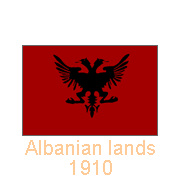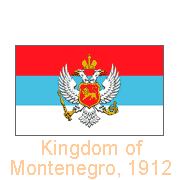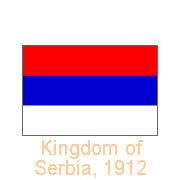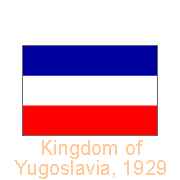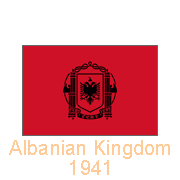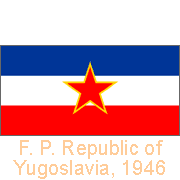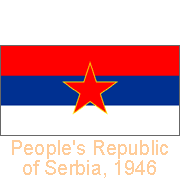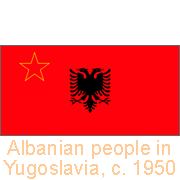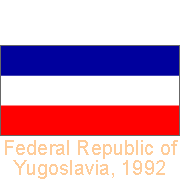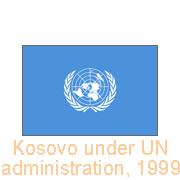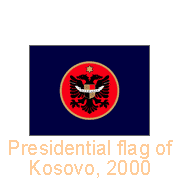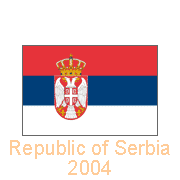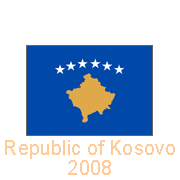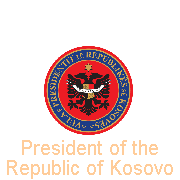Flags from Kosovo
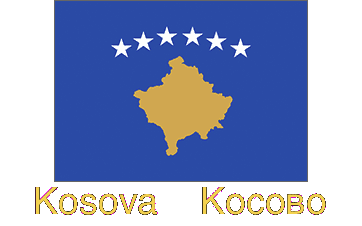
A Flag history of Kosovo
The Battle of Kosovo in 1389 ended Serbian domination of the area and Kosovo was formally part of the Ottoman Empire from 1455 to 1912. In 1844 the Ottoman Empire adopted a flag identical to the present flag of Turkey; until then variants with different shaped crescents and an eight-pointed star had been used. The League of Prizren, an Albanian political organisation, was founded on 10 June 1878. It aimed to defend the Albanian lands from being annexed by Serbia (which claimed Kosovo) and Montenegro (which claimed northern Albania). Put down by the Turks in 1881, there were further revolts, and in 1910 the Albanian chief Isa Boletin raised the red flag with the black double-headed eagle. An autonomous government was proclaimed in June 1911, and the flag was raised in Prishtina, Kosovo, one of the Albanian “vilayets” of the Ottoman Empire. The independence of Albania was proclaimed in the city of Vlora on 28 November 1912.
you may then send it as a postcard if you wish.
The Principality of Montenegro had become a Kingdom under Nicholas I in 1910. It arranged “incidents” on its southern border in August and September 1912 and in October joined Serbia, Greece, and Bulgaria in the First Balkan War against the Ottoman Empire. It occupied the western Kosovo region of Metohija, from Peja to Prizren, with great brutality, resulting in thousands of deaths among the Albanian population. Northern Metohija was recognised as part of Montenegro at the Treaty of London in May 1913. Montenegro’s flag at that time displayed the Pan-Slavic colours, inspired by Russia, although with a lighter colour blue, to distinguish it from the Serbian flag. The coat of arms in the State flag, a golden-crowned double-headed eagle on a red background, dates back to the 15th Century. The Principality of Serbia had become a Kingdom in 1882 under Milan Obrenović IV. Its flag, modelled on the Russian one but with its colours reversed, dates from October 1835. This was five years after the Principality of Serbia had been proclaimed as a vassal state of the Ottoman Empire. On 18 October 1912, it declared war on the Ottoman Empire but had already sent troops before that into Kosovo. Although meeting stiff resistance from Kosovar Albanians, they occupied the country, destroying and massacring Albanian villages, reaching Prishtina on 22 October. After the First Balkan War of 1912, Kosovo was internationally recognised as a part of Serbia at the Treaty of London in May 1913. In late 1918 a new state, the Kingdom of Serbs, Croats, and Slovenes, was formed. It consisted of the newly united Kingdoms of Serbia and Montenegro with the short-lived State of Slovenes, Croats, and Serbs that encompassed the southern Slavic lands of the former Austro-Hungarian Empire. In 1929 it was renamed Jugoslavija (in Serbian Cyrillic: Југославија); “jugo” means “south”: hence “the land of the Southern Slavs”. As Kosovo had been incorporated into Serbia in 1912, it became part of this state also. Its flag used the same Pan-Slavic colours as existed in the regions, now united in one country, but in the order blue-white-red.
In 1939 Italian forces had taken control of Albania and made their king, Vittorio Emmanuele III, the ruler of the country. In 1941 the German army invaded Yugoslavia and occupied Kosovo within a week. On 21 April 1941, it was agreed between the German and Italian governments that the most substantial part of this Albanian-inhabited territory should be put under Italian control and joined to Albania. This was formalised in July, and by decree, in October 1941 all inhabitants of Italian-occupied Kosovo became Albanian citizens. The Albanian flag that had been adopted on 3 June 1939 was red with a shield containing the double-headed eagle, crowned by the helmet of Skanderbeg, Albania’s 15th-century national hero. This was supported by two black fasces, connected above by two Savoy ribbons in black, and below by a black scroll with the motto of the House of Savoia: “FERT” (Foedere Et Religione Tenemur: Latin for “We are held together by Pact and Religion”). Tens of thousands of Serbs were driven out of Kosovo during this time.
Italy’s Fascist regime collapsed in 1943. Although in 1944 Kosovar communist resistance leaders passed a resolution on the postwar assignment of Kosovo to Albania, this was disregarded. Kosovo was eventually liberated in 1944 with the help of Albanian partisans and fell to Yugoslavia again. During the Second World War, the Kingdom of Yugoslavia was abolished, and Tito’s partisans established a communist federal state, “Democratic Federative Yugoslavia”. This was renamed “Federal People’s Republic of Yugoslavia” in 1946 and, in 1963, “Socialist Federative Republic of Yugoslavia”. A flag with a red star just inside the white field was used during the war. The version with the yellow-outlined red star was officially adopted 31 January 1946. On 17 January 1947 the Serbian tricolour, red-blue-white, with a communist star was adopted for the “People’s Republic of Serbia”. In 1963 it was renamed “Socialist Republic of Serbia”. Kosovo became the “Autonomous Region of Kosovo and Metohija”, without a flag of its own. However, the Albanian ethnic minority of Yugoslavia did have a flag from the late 1940s to the late 1980s. It was, in fact, an Albanian flag in proportions 1:2 with the Yugoslav communist yellow outlined red star at the hoist. On 2 July 1990, a parallel parliament representing the ethnic Albanian population of Kosovo declared Kosovo an independent country, the Republic of Kosova. On 2 September 1991, the Parliament of the Republic of Kosova adopted the Resolution of Independence. The flag used was the Albanian flag, the “Flamur e Skënderbeut” (Skanderbeg’s flag): a red field with a black double-headed eagle, identical to the flag of Albania. The state was only recognised by Albania.
On 27 April 1992, the word “Socialist” was dropped and the communist star removed from the Yugoslav flag. On 14 March 2002, after all former Yugoslav republics except Montenegro had become independent, an agreement on the Union of Serbia and Montenegro was signed. The state was henceforth called “Serbia and Montenegro”. This lasted until Montenegro declared independence on 3 June 2006. Meanwhile, the Kosovo Liberation Army or KLA (Albanian: Ushtria Çlirimtare e Kosovës or UÇK), a Kosovar Albanian guerrilla group seeking the independence of Kosovo from Yugoslavia in the 1990s, campaigned against Serbian security forces. That precipitated a major Yugoslav military crackdown which led to the Kosovo War of 1998-1999. At the end of the war in 1999, the KLA was officially disbanded under the United Nations Administration, and their members entered the Kosovo Protection Corps (KPC). During the United Nations Administration from 1999 until 17 February 2008 the flag of the United Nations was used for official and government purposes in Kosovo. Ibrahim Rugova, the first president of the Republic of Kosova, introduced the “flag of Dardania” as a Presidential State Flag on 29 October 2000. Dardania is the name of an ancient region in the same general area as Kosovo. This flag did not gain much popularity but was occasionally used at cultural and sports events during the United Nations Interim Administration Mission in Kosovo (UNMIK) period and also used at Rugova’s funeral to cover his coffin. Meanwhile, in August 2004 a new flag was raised for Serbia, of which Kosovo was still officially a province, displaying a coat of arms based on that of the Kingdom of Serbia of 16 June 1882. Following the dissolution of “Serbia and Montenegro” with the independence of Montenegro, Serbia became the successor state of Yugoslavia on 5 June 2006.
On 17 February 2008, the Parliament of Kosovo declared independence from Serbia over its objections and adopted a flag and arms. The flag of Kosovo avoids symbols associated with particular ethnic groups. It is blue with a yellow geographical map of Kosovo and six white five-pointed stars forming an arch above it. The blue colour represents the goals of the people of Kosovo for Euro-Atlantic integration. The golden yellow coloured map represents Kovoso as a prosperous and peaceful country. The white stars above the map represent the communities living in Kosovo: Albanian, Serb, RAE (Roma, Ashkali and Egyptian), Bosniak, Turkish, and Goran (Macedonian). A former KLA leader, Hashim Thaçi, became the first Prime Minister of an independent Kosovo.



